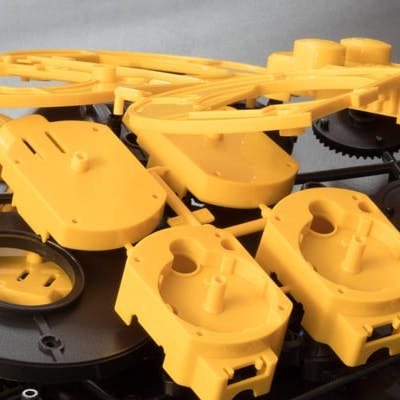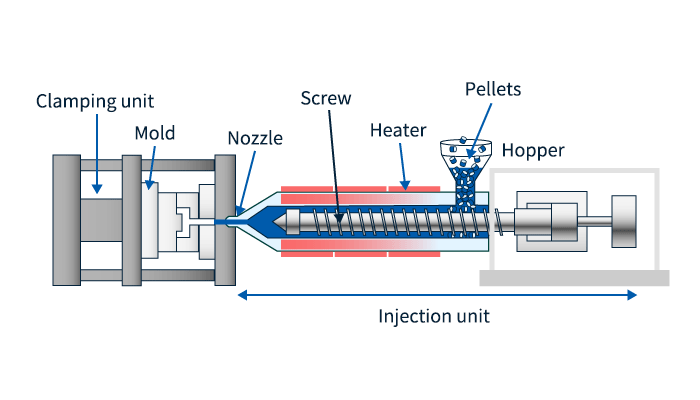Recognizing the Basics of Plastic Shot Molding Procedures
Plastic injection molding serves as a cornerstone of modern-day manufacturing, offering a methodical approach to producing complicated parts with accuracy. Discovering these essential elements can disclose exactly how even minor adjustments can lead to significant renovations in manufacturing results, raising inquiries regarding the potential for innovation in this well-known procedure.
What Is Plastic Injection Molding?
Plastic shot molding is a widely used manufacturing process that changes thermoplastic and thermosetting materials right into precise and intricate shapes. This method is preferred for its capability to generate high volumes of similar get rid of phenomenal accuracy, making it a crucial technique in numerous markets, including automotive, customer items, and medical tools.
The process includes thawing the picked plastic material and injecting it right into a mold and mildew under high pressure. The mold, created to the specifications of the desired component, enables the liquified plastic to take shape as it strengthens and cools down. Once the material has solidified, the mold and mildew is opened up, and the finished component is ejected.
Plastic shot molding uses several benefits, including reduced waste, consistency in manufacturing, and the capacity to integrate complex layouts that may be testing with various other producing approaches. In addition, it supports a broad variety of products, each offering one-of-a-kind residential properties that can be tailored for particular applications. As markets continue to innovate, plastic injection molding stays at the center, making it possible for the advancement of advanced items that fulfill advancing customer needs.
The Shot Molding Process
The shot molding process is an advanced method that entails several key phases to generate top notch plastic parts. At first, plastic pellets are fed right into a warmed barrel where they are melted right into a viscous fluid. This molten plastic is after that injected under high stress into a precision-engineered mold, which forms the product into the desired kind.
When the mold is filled, the plastic is permitted to strengthen and cool, taking the form of the mold and mildew dental caries. Air conditioning time is critical, as it influences the cycle time and the final residential or commercial properties of the shaped component. After sufficient air conditioning, the mold and mildew opens, and the ended up element is expelled utilizing ejector pins.

Products Utilized in Injection Molding
Various materials can be utilized in the injection molding procedure, each offering one-of-a-kind residential or commercial properties that satisfy certain applications. One of the most frequently made use of products include thermoplastics, thermosetting plastics, and elastomers.

Thermosetting plastics, like epoxy and phenolic materials, undergo a chemical adjustment during the treating procedure, resulting in a stiff, stringent structure. These materials are ideal for applications needing high warmth resistance and structural stability, often utilized in vehicle components and electric insulators.
Elastomers, consisting of silicone and rubber-based products, offer versatility and strength. Their unique residential properties make them suitable for applications that demand elasticity, such as seals and gaskets.
Furthermore, specialized products like bio-based plastics and compounds are gaining traction for their environmental benefits and improved efficiency attributes, widening the scope of injection molding applications in various industries. Comprehending the buildings of these products is crucial for selecting the suitable type for particular jobs.
Advantages of Injection Molding
Injection molding stands apart as a highly efficient manufacturing process that offers numerous advantages for creating intricate parts with accuracy. Among one of the most substantial advantages is the capability to produce elaborate designs that would be tough or difficult to achieve with various other approaches (Plastic Injection Molding). The procedure enables comprehensive features and tight resistances, making sure top notch elements
Additionally, shot molding is understood for its rapid manufacturing capacities, making it a suitable option for high-volume manufacturing. As soon as the mold is developed, components can be produced promptly, minimizing lead times and raising general productivity. This performance not only reduces production prices however also gives a competitive side in the marketplace.
The adaptability of materials utilized in shot molding additionally enhances its charm. A large range of thermoplastics and thermosetting polymers can be employed, enabling suppliers to choose products that best fulfill their certain needs, consisting of stamina, warmth, and flexibility resistance.
In addition, the process decreases waste, as excess product can frequently be recycled and reused. This sustainability facet contributes to a reduced ecological effect, making injection molding an accountable manufacturing choice. In general, the benefits of injection molding make it a favored technique for numerous sectors.
Factors Impacting Product High Quality
While countless elements can influence product quality in shot molding, understanding these elements is vital for accomplishing ideal outcomes. Secret facets include product option, processing parameters, and mold style.
Product choice plays an essential duty, as different polymers exhibit one-of-a-kind residential properties that influence flowability, stamina, and thermal stability. Inadequate product option can lead to issues such as warping or incomplete dental filling.
Processing parameters, consisting of cycle, pressure, and temperature time, need to be thoroughly controlled. Variants in these setups can result in variances in part measurements and surface finish. For instance, excessively high useful reference temperature levels may trigger degradation of the polymer, while insufficient pressure can lead to short shots.
Mold and mildew style is equally essential, as it establishes the flow of the molten plastic and the cooling process. Poorly created mold and mildews might result in unequal cooling rates, resulting in residual stress and anxieties and dimensional mistakes.

Final Thought
To conclude, plastic shot molding functions as an important production procedure that enables the effective manufacturing of high-grade elements. Mastery of the shot molding process, consisting of the understanding of materials and the influence of numerous factors look at this now on item high quality, is essential for achieving optimum outcomes. The benefits of this technique, such as cost-effectiveness and layout adaptability, additional underscore its significance throughout numerous sectors, solidifying its standing as a favored choice for high-volume production.
Plastic shot molding serves as a cornerstone of modern manufacturing, offering a systematic technique to producing complicated components with accuracy.Plastic injection molding provides several benefits, consisting of reduced this article waste, consistency in production, and the capacity to incorporate intricate designs that might be challenging with various other making approaches (Plastic Injection Molding). As industries continue to innovate, plastic injection molding continues to be at the leading edge, making it possible for the development of innovative products that fulfill progressing consumer demands
The injection molding procedure is an innovative method that includes several key stages to generate premium plastic parts.In conclusion, plastic shot molding offers as a critical manufacturing procedure that makes it possible for the reliable production of premium parts.
Comments on “Comprehending the Plastic Injection Molding Process for High-Quality Manufacturing”